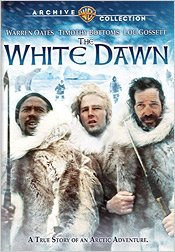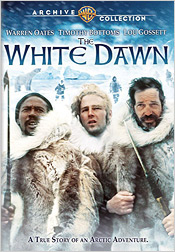White Dawn, The (MOD DVD Review)

Director
Philip KaufmanRelease Date(s)
1974 (June 25, 2013)Studio(s)
Paramount (Warner Archive)- Film/Program Grade: B+
- Video Grade: C+
- Audio Grade: B+
- Extras Grade: B+
Review
Philip Kaufman may not be the most prolific filmmaker to emerge out of the 1970s New Hollywood scene but at his best, he is as interesting and talented as any of them. As a screenwriter, he contributed to the writing of The Outlaw Josey Wales and Raiders Of The Lost Ark. As a director, he helmed the impressive 1978 remake Invasion Of The Body Snatchers, The Right Stuff, one of the very best movies of the 80s, and was responsible for the creation of the NC-17 rating with Henry & June in 1990. But for all that, he remains relatively uncelebrated and undervalued.
The White Dawn was Kaufman’s second Hollywood feature and remains one of his best. Based on a true story, the film casts Warren Oates, Timothy Bottoms and Louis Gossett Jr. as whalers stranded high up in the Arctic when their boat crashes on the ice thanks to Oates’ single-minded determination to bring in a whale. The other men on board die and these three are close to death themselves when they’re saved by a tribe of Inuits.
The tribe’s leader proclaims that the three men are “Dog-Children”, offspring of one of their own women and the Dog Spirit, and takes them in. Bottoms, the youngest, adapts quickly, learning the language and forming kinships with his hosts. Gossett remains an outsider but enjoys the tribe’s hospitality, while Oates schemes and dreams up ways to take advantage of their good nature.
At its simplest level, The White Dawn is a gripping survival adventure. You don’t need to listen to the commentary to realize immediately that this was an incredibly difficult film to make. Shot completely on location on Baffin Island in the Canadian Arctic, the cast and crew had to contend with snow, rain, ice, and temperatures that frequently hovered waaaaay below zero. This isn’t the kind of movie where the cast has to do much acting to convey their physical hardships.
But it’s the friction between the two cultures that gives the movie its real interest and makes it worth returning to. The indigenous people were cast entirely with local, non-professional actors and they lend the film both authenticity and dignity. Everything about them, their furs, their rituals, their hunts, seems genuine and real. It’s fascinating to see Bottoms’ attempts to assimilate, to see what actions give offense and which ones don’t, and to see the Inuits initially laugh off their Shaman’s warning that the Dog-Children will bring nothing but trouble and bad luck. Almost nothing plays out the way you might expect it to. It’s a remarkably well-rounded portrait of both Western and Inuit cultures.
Warner Archive’s re-release of The White Dawn is a direct port of Paramount’s fine 2004 DVD. Video quality is decent but inconsistent, with some shots marred by extremely noticeable dirt and scratching. Michael Chapman’s cinematography would certainly benefit from a full restoration and an HD upgrade but considering the obscurity of the title, I’m not surprised this didn’t happen. Audio is presented in both the original mono and a well-done 5.1 mix.
Extras include a brief introduction by Kaufman and a commentary that’s certainly worth your time. The disc also two featurettes. Welcoming The Dawn looks at the making of the film via interviews with Kaufman, producer Martin Ransohoff and film scholar Annette Insdorf. A Way Of Life is a straightforward but interesting look at Inuit culture.
The White Dawn is a film long overdue for rediscovery. It features extraordinary performances by both its professional and non-professional cast, indelible images, and haunting music courtesy of both the Inuits themselves and composer Henry Mancini, turning in one of his strongest and most unusual scores. It’s a real sleeper that deserves a bigger audience.
- Dr. Adam Jahnke

